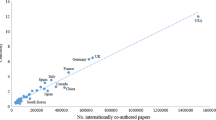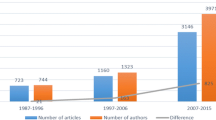Abstract
The study explores the international collaboration network consisting of 606 astronomical institutions through the analysis of international coauthored papers published in six journals in astronomy and astrophysics from 2001 to 2009. It shows that the Istituto Nazionale di Astrofisica (INAF) and European Southern Observatory (ESO) are the most notable actors, with the highest values of centrality in the network, while Japan Meteorological Agency (JMA) is the only institution that is completely separated from others. It is observed that national academies in major countries, international organizations, and large observatories are more likely to be the central actors. Yet some world-famous astronomical institutions, such as CfA, NASA, and Caltech, are identified as remarkable actors in the network, they show no strikingly high scores in the centrality measures. Overall, astronomical institutions’ network position varies with time; nevertheless, not all of institutions present considerable changes during the investigation periods. While some institutions moved from central to relative peripheral positions, or in the opposite direction, the institutions which are positioned at the very center of the network tend to be stable over time.
Similar content being viewed by others
Notes
There are eight astronomical institutions, including the Center for Backyard Astrophysics, European Southern Observatory (ESO), European Space Agency (ESA), Gemini Observatory, the International Center for Astronomical, Medical and Ecological Research (ICAMER), the Institut de Radioastronomie Millimétrique (IRAM), National Optical Astronomy Observatory (NOAO), and Vatican Observatory classified as international organizations in the study. These institutions are presented at the highest level of organization in the analysis.
Five institutions, including Imperial College London, the Swinburne University of Technology, the Universidad de Chile, the Universidade do Porto, and the University of Hertfordshire, are newly appeared in the lists of degree and closeness centrality. One institution, the University of Texas at Austin, is newly appeared in the lists of closeness and betweenness centrality. Twelve institutions, including Göteborgs universitet, the Istituto Nazionale di Fisica Nucleare, Korea Astronomy and Space Science Institute, Krakow Pedagogical University, M.V. Lomonosov Moscow State University, the Max-Planck-Institut für Kernphysik, the Max-Planck-Institut für Sonnensystemforschung, South African Astronomical Observatory, the Universität Hamburg, the Universiteit Utrecht, the University of Leeds, and the University of Southampton, are newly appeared in the list of betweenness centrality. Five institutions, including CNR, Durham University, the Isaac Newton Group of Telescopes, Johns Hopkins University, and the Space Research Organization Netherlands, are newly appeared in the lists of degree, closeness, and betweenness centrality.
References
Abt, H. A. (1981). Some trends in American astronomical publications. Publications of the Astronomical Society of the Pacific, 93(553), 269–272.
Abt, H. A. (1990). Trends toward internationalization in astronomical literature. Publications of the Astronomical Society of the Pacific, 102(649), 368–372.
Abt, H. A. (2000). What can we learn from publication studies. In A. Heck (Ed.), Organizations and strategies in astronomy (pp. 77–90). Dordrecht: Kluwer Academic Publishers.
Abt, H. A. (2007). The frequencies of multinational papers in various sciences. Scientometrics, 72(1), 105–115.
Adams, J. D., Black, G. C., Clemmons, J. R., & Stephan, P. E. (2005). Scientific teams and institutional collaborations: Evidence from US universities, 1981–1999. Research Policy, 34(3), 259–285.
Aksnes, D. W. (2003). Characteristics of highly cited papers. Research Evaluation, 12(3), 159–170.
Arunachalam, S., Srinivasan, R., & Raman, V. (1994). International collaboration in science: Participation by the Asian giants. Scientometrics, 30(1), 7–22.
Barjak, F., & Robinson, S. (2007). International collaboration, mobility and team diversity in the life sciences: Impact on research performance. Social Geography Discussions, 3, 121–157.
Beaver, D. d., & Rosen, R. (1978). Studies in scientific collaboration. Part I. Professional origins of scientific co-authorship. Scientometrics, 1(1), 65–84.
Bordons, M., Gómez, I., Fernández, M. T., Zulueta, M. A., & Mendez, A. (1996). Local, domestic and international scientific collaboration in biomedical research. Scientometrics, 37(2), 279–295.
Georghiou, L. (1998). Global cooperation in research. Research Policy, 27(6), 611–626.
Geuna, A. (1998). Determinants of university participation in EU-funded R & D cooperative projects. Research Policy, 26(6), 677–687.
Glänzel, W. (2000). Science in scandinavia: A bibliometric approach. Scientometrics, 48(2), 121–150.
Glänzel, W. (2001). National characteristics in international scientific co-authorship relations. Scientometrics, 51(1), 69–115.
Glänzel, W., & de Lange, C. (2002). A distributional approach to multinationality measures of international scientific collaboration. Scientometrics, 54(1), 75–89.
Glänzel, W., & Schubert, A. (2001). Double effort = Double impact? A critical view at international co-authorship in chemistry. Scientometrics, 50(2), 199–214.
Glänzel, W., Schubert, A., & Czerwon, H. J. (1999). A bibliometric analysis of international scientific cooperation of the European Union (1985–1995). Scientometrics, 45(2), 185–202.
Hearnshaw, J. (2007). A survey of published astronomical outputs of countries from 1976 to 2005 and the dependence of output on population, number of IAU members and gross domestic product. In J. Hearnshaw & P. Martinez (Eds.), Astronomy for the developing world (pp. 9–19). Cambridge: Cambridge University Press.
Heck, A. (2000). Astronomy-related organizations: Geographical distributions, ages and sizes. In A. Heck (Ed.), Organizations and strategies in astronomy (pp. 7–66). Dordrecht: Kluwer Academic Publishers.
Leydesdorff, L. (2000). Is the European Union becoming a single publication system? Scientometrics, 47(2), 265–280.
Leydesdorff, L., & Wagner, C. S. (2008). International collaboration in science and the formation of a core group. Journal of Informetrics, 2(4), 317–325.
Lorigo, L., & Pellacini, F. (2007). Frequency and structure of long distance scholarly collaborations in a physics community. Journal of the American Society for Information Science and Technology, 58(10), 1497–1502.
Luukkonen, T., Persson, O., & Sivertsen, G. (1992). Understanding patterns of international scientific collaboration. Science, Technology and Human Values, 17(1), 101–126.
Luukkonen, T., Tijssen, R. J. W., Persson, O., & Sivertsen, G. (1993). The measurement of international scientific collaboration. Scientometrics, 28(1), 15–36.
Marshakova-Shaikevich, I. (2006). Scientific collaboration of new 10 EU countries in the field of social sciences. Information Processing and Management, 42(6), 1592–1598.
Miquel, J. F., & Okubo, Y. (1994). Structure of international collaboration in science. Part II. Comparisons of profiles in countries using a link indicator. Scientometrics, 29(2), 271–297.
Nagpaul, P. S., & Sharma, L. (1994). Research output and transnational cooperation in physics subfields: a multidimensional analysis. Scientometrics, 31(1), 97–122.
Narin, F., Stevens, K., & Whitlow, E. S. (1991). Scientific co-operation in Europe and the citation of multinationally authored papers. Scientometrics, 21(3), 313–323.
Newman, M. E. J. (2004). Coauthorship networks and patterns of scientific collaboration. PNAS Proceedings of the National Academy of Sciences of the United States of America, 101(suppl. 1), 5200–5205.
Ruane, F., & Tol, R. S. J. (2008). Rational (successive) h-indices: An application to economics in the Republic of Ireland. Scientometrics, 75(2), 395–405.
Russell, J. M., & Almada de Ascencio, M. (1997). Patterns of Collaboration of Scientists at the National University of Mexico (UNAM). International Scientific Migrations. Retrieved from http://horizon.documentation.ird.fr/exl-doc/pleins_textes/divers4/010022327-10.pdf. Accessed 6 Jan 2008.
Suárez-Balseiro, C., Sanz-Casado, E., & Ortiz-Rivera, L. (2006). Patterns of international scientific co-operation in Puerto Rico. Scientometrics, 67(3), 335–350.
van Raan, A. F. J. (1998). The influence of international collaboration on the impact of research results: Some simple mathematical considerations concerning the role of self-citations. Scientometrics, 42(3), 423–428.
Velho, L. (1995). International Scientific Collaboration in Brazil. The case of The Amazonia National Research Institute. Paper presented at the Fifth International Conference of the International Society for Scientometrics and Informetrics.
Wagner, C. S. (2005). Six case studies of international collaboration in science. Scientometrics, 62(1), 3–26.
Wagner, C. S., & Leydesdorff, L. (2005). Mapping the network of global science: Comparing international co-authorships from 1990 to 2000. International Journal of Technology and Globalisation, 1(2), 185–208.
White, J. C. (1992). Publication rates and trends in international collaborations for astronomers in developing countries, Eastern European Countries, and the former Soviet Union. Publications of the Astronomical Society of the Pacific, 104(676), 472–476.
Yoon, Y. H., & Young, K. S. (2008). Correlation analysis between university research competitiveness and library’s scholarly information in OECD nations and Korea. Scientometrics, 74(3), 345–360.
Author information
Authors and Affiliations
Corresponding author
Electronic supplementary material
Below is the link to the electronic supplementary material.
Rights and permissions
About this article
Cite this article
Chang, HW., Huang, MH. Prominent institutions in international collaboration network in astronomy and astrophysics. Scientometrics 97, 443–460 (2013). https://doi.org/10.1007/s11192-013-0976-x
Received:
Published:
Issue Date:
DOI: https://doi.org/10.1007/s11192-013-0976-x




